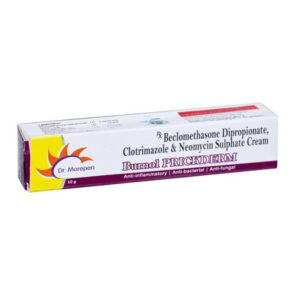CLOTRIMAZOLE + NEOMYCIN AND CLOTRIMAZOLE + BECLOMETHASONE DIPROPIONATE
Clotrimazole: Clotrimazole is an antifungal medication primarily used to treat fungal infections. It belongs to the class of drugs known as azoles, which work by inhibiting the growth of fungus.
This medication is commonly used to treat various types of fungal infections, including vaginal yeast infections, oral thrush, ringworm, athlete’s foot, and jock itch. It comes in various forms such as creams, sprays, powders, and troches (lozenges).
Clotrimazole works by interfering with the synthesis of ergosterol, a vital component of fungal cell membranes. This disruption weakens the cell membrane, leading to leakage of intracellular contents and ultimately killing the fungus.
The dose of clotrimazole varies depending on the type and severity of the infection. For vaginal yeast infections, a typical dose is 1% cream or suppository inserted into the vagina once daily for 7 to 14 days. For athlete’s foot or jock itch, clotrimazole cream or powder can be applied to the affected area twice a day for 2 to 4 weeks.
As with any medication, clotrimazole may have potential side effects. Common side effects include local skin irritation, itching, burning, or redness at the site of application. These reactions are usually mild and resolve on their own. In rare cases, allergic reactions such as rash, hives, or difficulty breathing may occur. If any severe or persistent side effects occur, it is important to seek medical attention immediately.
It is worth noting that clotrimazole may interact with certain medications, so it is important to inform your healthcare provider about any other medications you are taking before starting clotrimazole treatment.
Overall, clotrimazole is an effective antifungal medication that is widely used to treat fungal infections. It is generally safe and well-tolerated, but it is always recommended to follow the prescribed dose and consult a healthcare professional if any concerns arise.
Neomycin And Clotrimazole: Neomycin and Clotrimazole is a combination medication used for the treatment of various types of skin infections, including fungal and bacterial infections. It contains two active ingredients: Neomycin, which is an antibiotic, and Clotrimazole, which is an antifungal agent.
Neomycin works by inhibiting the growth of bacteria. It does this by interfering with the production of proteins needed for bacterial cell growth. Clotrimazole, on the other hand, works by disrupting the cell membrane of fungi, which leads to their death.
This combination medication comes in the form of a cream or ointment and is typically applied topically to the affected area. It is important to follow the instructions provided by your healthcare provider or the product label regarding the frequency and duration of application.
As for the side effects, Neomycin and Clotrimazole can cause mild skin irritation, such as burning, itching, or redness at the application site. Some people may also experience an allergic reaction to the medication, characterized by rash, swelling, or difficulty breathing. If any severe or persistent side effects occur, it is important to seek medical attention.
It is worth mentioning that Neomycin and Clotrimazole should not be used in certain circumstances, such as if you have a known allergy to any of its components or if you have a viral or deep-seated fungal infection. It is always important to consult with your healthcare provider before starting any new medication to ensure it is safe and appropriate for you.
Beclomethasone Dipropionate: Beclomethasone dipropionate is a corticosteroid medication used to control and prevent symptoms such as wheezing, shortness of breath, and coughing caused by asthma. It belongs to the class of drugs known as inhaled corticosteroids.
The main mechanism of action of beclomethasone dipropionate is its anti-inflammatory effect. It reduces the inflammation in the airways, making them less sensitive and therefore less likely to react to triggers. This helps to relieve symptoms and prevent asthma attacks.
Beclomethasone dipropionate is typically administered using a metered-dose inhaler (MDI) or a dry powder inhaler (DPI). The dose may vary depending on the severity of asthma symptoms, and it is important to follow the prescribed instructions and guidelines provided by your healthcare provider. The usual recommended dose for adults is 80-320 micrograms per day, divided into two or four doses.
As with any medication, beclomethasone dipropionate can cause side effects. Common side effects include a sore throat, hoarseness, or fungal infection in the mouth (thrush). Gargling with water and rinsing the mouth after each use can help minimize the risk of thrush. Other possible side effects include cough, dry mouth, headache, dizziness, nausea, and nosebleeds. These side effects are generally mild and go away on their own. However, if you experience any severe side effects or have concerns, it is important to consult with your healthcare provider. They can provide guidance and determine if any adjustment to the medication is necessary.
It is worth noting that beclomethasone dipropionate is not a rescue medication for sudden asthma attacks. For acute symptoms, a short-acting bronchodilator should be used instead. Beclomethasone dipropionate is typically used as a long-term maintenance medication to manage asthma symptoms and reduce the frequency and severity of asthma attacks.
Overall, beclomethasone dipropionate is a commonly prescribed medication for the management of asthma. It effectively reduces airway inflammation and helps control symptoms in individuals with asthma.

